by Patrick Boniface
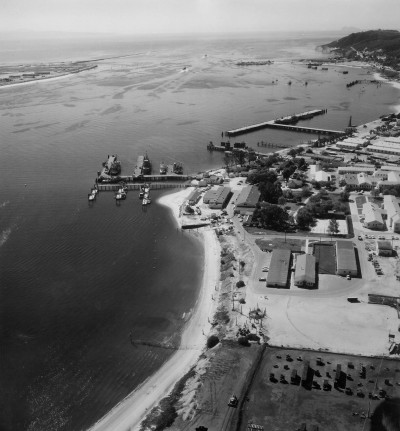
Sun, sand and a warm welcome are all assured to visitors to California’s southernmost and most sunny city, San Diego. The sunshine city of San Diego boasts one of the world’s best climates as well as one of the world’s largest natural harbours that have for centuries been home to commerce, pleasure and the military.
Juan Rodrigues Cabrillo, the Spanish explorer, first sailed into the long dog-leg of a bay in 1542 onboard his flagship the San Salvador from Navidad in Mexico and founded a settlement that would, five hundred years, later become the modern and surprisingly compact city of San Diego.
Over the last thirty years the port has become a regular stopover for cruise ships with many of the major players in the marketplace on the Pacific Ocean routes basing a number of their ships in the city. With Mexico just 20 miles or so to the south it is ideally located for the cruise ship market. Whether it’s large cruise ships, massive nuclear powered aircraft carriers, destroyers bristling with guns and missiles, fishing boats, yachts or commercial tankers San Diego is undoubtedly one of the planet’s super ports.
A Brief History
For almost five hundred years the port of San Diego has played a crucial role in the development of this part of southern California. It is perhaps appropriate to take a quick look at some of the history. In 1869 Alonzo Horton completed a wharf at the end of 5th Street at the cost of around $45,000, then a considerable sum of money.
In 1913 Broadway Pier was constructed with a $1.7 million bond issued by the city of San Diego. Whilst six years later San Diego Harbour Commission and Harbour Department were first established to look after navigation and development issues within the Bay area. By 1955 expansion was on the minds of the citizens of San Diego who approved a $9.5million bond to build Tenth Avenue Marine Terminal. In order to better control the administration of the harbour on 18th December 1962 The San Diego Unified Port District was created when the State approved Senate Bill 41.
Under the bill all transport movements within San Diego were to come under the one authority including aviation, marine and land and rail transportation. The first meeting of the Board of Port Commissioners convened in January 1963.
1963 also saw the completion of a bulk loading facility at the 10th Avenue Terminal and soon construction was underway of 300,000 square feet of warehouses nearby. Construction of the 24th Street Marine Terminal was launched in 1966 with $3.9 million bond issue as well as a matching sum of finance from federal funds. Two years later in November 1968 cargo began being handled by the National City Marine Terminal.
The citizens of San Diego had for decades seen their port being developed but some still wanted a place to enjoy themselves alongside the bay, so in 1970 the old Broadway Cargo Pier was converted into a landscape esplanade. Later that year in November saw the arrival of the first cruise ship to offer scheduled cruises out of San Diego. The Greek MS Orpheus of Eprotiki Lines began making scheduled ten day cruises to Mexico from B Street and Broadway Piers.
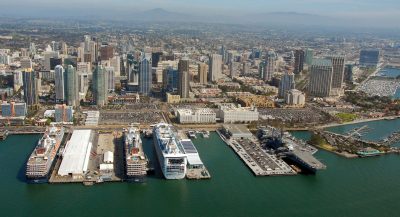
The Rotterdam, the world’s largest cruise ship of the time, in 1975, visited San Diego on the final leg of a three month around the world cruise. The following year a new area of land for the bay was created when sand dredged from the bay was used to create North and South Embarcadro Marine Park, which has gone on to be become one of the city’s most popular parks.
In March 1978 a $1.5 million pier at the G Street Mole (now Tuna Harbor) was dedicated to support the commercial fishing industry in San Diego. 1978 also saw $19 million being spent on dredging the main channel to allow for larger vessels to reach the National City Marine Terminal and to improve the facilities commercial viability.
NASSCO, San Diego’s main shipbuilder received a major addition to its facilities in November 1983 when after having been towed the 5,266 miles from Japan a specially constructed 620 foot long dry dock costing £21 million arrived in San Diego and was immediately put into service on ship repair work. Two years later B Street Pier was refurbished into a modern cruise line terminal at a cost of some $3.5million. One of the world’s most famous ships Princess Line’s Pacific Princess was, in 1985, home-ported at San Diego. This ship had become famous as ‘The Love Boat’ from the TV show of the same name.
In August 2001 a record number of vehicles were imported through National City Marine Terminal. The facility processed no fewer than 3,894 Honda and Acuras that month. Seven years later in November 2008, in a show of public support for the Port of San Diego, citizens voted down a proposal to transform 10th Avenue into a sports stadium and hotel complex. The proposal was overwhelmingly defeated and commercial operations were allowed to continue.

The Situation Today
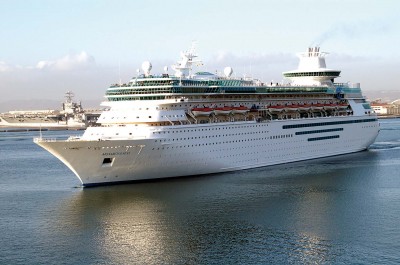
The San Diego Port Authority controls all aspects of the city’s transportation links be they aviation at nearby Lindberg Field International Airport or within the confines of the beautiful harbour. From the relatively small entrance between Ballast Point and Zuniga Point San Diego Bay stretches back in a long lazy dog-leg shape for around twelve miles and through centuries of continuous development and redesign has a unique layout. Each area has a designated function and purpose within the bay area with the main commercial areas being the Cruise Ship Terminal and the shipyard of NASSCO where huge supertankers and naval auxiliary vessels can be seen slowly reaching skyward on a regular basis.
Any visitor to San Diego will quickly discover that the port is a Navy town with coastguard stations at Point Loma as well as the sinister black, sleek, shapes of nuclear powered hunter killer submarines nearby too. Alongside the submarines are a number of oceanographic, survey and research vessels, before the military is replaced with the gin palaces and motorboat and yacht playthings of America’s rich and famous. The million dollar yachts are gathered around Shelter Island and Harbour Island. Only thirty years ago, this whole area was also US Navy control but savage defence cutbacks in the 1990’s saw it sold to commercial enterprises who developed a colourful collection of marinas and harbour developments.
Unlike a great many ports around the world, San Diego is reasonably accessible for the ship enthusiast. There are hundreds of excellent vantage points from which to witness the various ships sailing past. A word of caution, however, if you take photographs of the warships you may be approached by police officers wary of potential terrorist threats. If you have your passport with you it will help. One of the best sites for ship photography, as well as for history, is at San Diego Maritime Museum. Three wonderfully preserved historic ships are moored along the quayside.
These are the luxurious yacht Medea, the ferry Berkeley and the sail ship Star of India. A short walk away from this trio is the massive grey hull of the aircraft carrier USS Midway. Once the largest warship in the world, she served the US Navy for almost fifty years before becoming a fascinating museum ship in her homeport of San Diego.
Between the two is B Street Pier, where traditionally you can jump onboard a tour boat that will take passengers on one or two hour harbour cruises and seasonal whale watching excursions. The Coronado ferry also uses this pier on its regular run from one side of the bay to the other. Also between the historic ships is San Diego’s Cruise Ship Terminal located on Broadway Pier, which was in December 2010, developed as a second cruise ship pier. Between the two piers around one hundred and twenty ships make ports of call annually to California’s sunshine city. Today nine cruise lines including Carnival Cruise Line, Holland America, Celebrity Cruises and Royal Caribbean, and Holland America have San Diego as a home port during the winter season. 2008 proved to be the facilities busiest year yet when two hundred and fifty two ships called and over 800,000 passengers visited but over the following years trade has levelled out at an average of one hundred and three visits per year to San Diego.
With the fishing fields of the Pacific Ocean right on the city’s doorstep, it is not surprising that San Diego has a large fishing fleet principally catching Pacific Tuna. The trawlers main base of operations is located on G Street Pier. Next door is Seaport Village, the Embarcadero Marine Park and a large marina complex, where San Diego’s principal commercial port facilities are also located. This area is dominated by the impressive two and half mile long Coronado Bridge that links San Diego with Coronado and North Island. Underneath the bridge, however, is a hive of industry with a vast array of cargoes being processed from across the globe, with the main commodity being sand dredged from the continental shelf off California’s long coastline. The 10th Avenue Marine Terminal is home to, amongst others, ISP Alginates, North American Terminals Inc, BMH Marine and Team Southwest Marine.
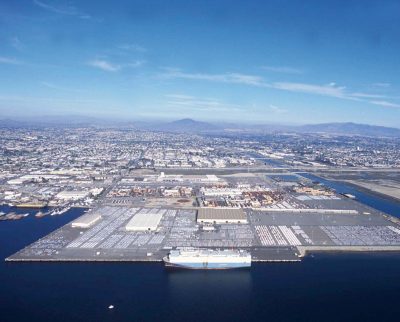
NASSCO (National Steel and Shipbuilding Corporation) is San Diego’s premier shipbuilder and ship-repairer. First established in 1905 as California Iron Works the small facility was, in 1922, taken over by US National Bank and renamed accordingly to National Iron Works. In 1949 the ship repair firm moved into building ships in its own right and was again renamed to better reflect this change in direction. The company’s new name was the National Steel and Shipbuilding Company or NASSCO for short. The American defence giant General Dynamics bought NASSCO in 1998 for $415 million. Within two years a further $135 million was spent by General Dynamics to upgrade the facilities at the San Diego yard to make them competitive with similar operations around the world. New management systems as well as new technologies were brought into the shipyard which greatly improved efficiency and reduced the man hours necessary to build ships in San Diego. NASSCO has, since 1949, built hundreds of ships including landing ships and auxiliary vessels for the US Navy and since 1959 the yard has also had considerable experience in the construction of commercial vessels. Perhaps the most famous ship to have been built by NASSCO was the supertanker Exxon Valdez, which left San Diego in 1986. Just three years later she returned to NASSCO for repairs following her disastrous oil spill in Alaska.
Today NASSCO is one of America’s most successful shipyards with work in hand from the US Navy for repairs and modernisations to Ticonderoga class cruisers, Wasp class assault ships and frigates and destroyers. They also are building a number of auxiliary vessels for the US Navy including the innovative Mobile Landing Platform program.
There are two other shipyards in San Diego. The first is Continental Maritime of San Diego and the second is Southwest Marine owned and operated by BAE Systems, who have recently (2013) won contracts with the US Navy.
US Navy Base
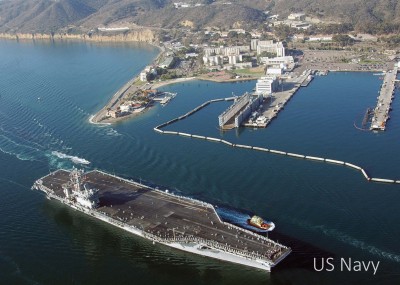
The US Navy’s presence in San Diego is felt after you pass under the Coronado Bridge. The base in San Diego is the second largest in the United States, only smaller than Norfolk in Virginia, the world’s largest naval base. Fourteen piers and no less than twelve miles of berthing space is available to the US Navy, which home ports sixty cruisers, destroyers, frigates, mine counter measure vessels, amphibious assault ships and support vessels at San Diego. Most of the repair work at San Diego is subcontracted out to NASSCO Shipyard or other local shipyards.
Almost at the end of San Diego Bay is one of the largest facilities in the entire bay area, National City Marine Terminal. Work to build this facility started in 1966 and today it annually processes 300,000 vehicles and timber products as well as providing additional support to the US Navy and US Marine Corps in the campaigns in Iraq and Afghanistan. With the drawdown on these commitments the Terminal has seen a return to its core business operations. National City Marine Terminal ends besides the Sweetwater River and, with the exception of a few marinas for pleasure craft and salt extraction works, the remainder of San Diego Bay to the north is relatively shallow.
The island of Coronado provides a home to the US Marine Corps’ US Naval Amphibious Base where the world famous SEALS special forces train and are based. The island is also home to one of the US Navy’s most important air bases located at Naval Air Station (NAS) North Island. This facility occupies a full two thirds of the island. North Island holds a unique place in the history of naval aviation as it was off the island on 14th November 1910 that pilot Eugene Ely flew his barely airworthy biplane from the deck of the cruiser HMS Birmingham and US Naval Aviation was born. Fittingly within sight of where this historic event took place is ‘Carrier Row’ where up to five of the US Navy’s supremely impressive Nimitz class aircraft carriers can be berthed along the eastern seafront of North Island. Whenever one of these aircraft carriers returns from, or leaves on, deployment it is a huge event in the city with thousands of locals and tourists alike lining the banks of the harbour to grab a look as the ship majestically slides into port with her ship’s company lining the sides in a perfectly executed ‘Procedure Alpha’.

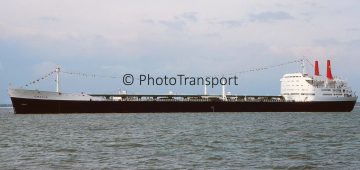



Comments
Sorry, comments are closed for this item